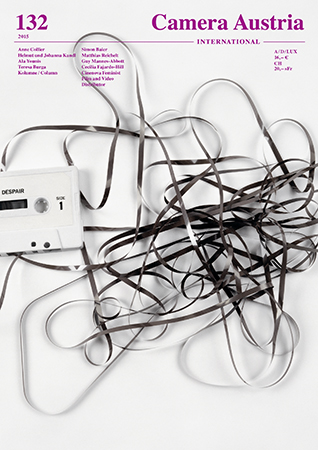Camera Austria International 132
Featuring:
Simon Baier on Anne Collier
Matthias Reichelt on Helmut und Johanna Kandl
Guy Mannes-Abbott on Ala Younis
Cecilia Fajardo-Hill on Teresa Burga
Column: Cinenova—Feminist Film and Video Distributor
Processes that determine the distribution of political, social, cultural, and economic agency have long been playing out—not just starting with the events currently culminating around flight and migration in Europe—attesting to dislocation in terms of geography and politics. The current issue of Camera Austria International focuses on four artistic positions, exemplary and antithetical in equal measure, in an attempt to explore the issue of the construction and reconstruction of history, of remembrance, and of cultural memory. In the case of Anne Collier, her work often deals with the re-representation of already published visual testimonials. As Simon Baier notes, “most of the found objects originate from a past that, though not specified, usually goes back to the pre-digital era … [they] are obsolete media in our present day and age.” But what does bringing supposedly obsolete material back into play mean, exposing it to a new gaze?
Helmut and Johanna Kandl have long engaged in travel, research, and photography, encountering a diverse range of people, friends of friends—in the Austrian Waldviertel, former Yugoslavia, former Czechoslovakia, and Ukraine. Memories, information, and pictures are arranged in an associative way, and banal motifs are constellated with world-historical ones—not as counter-narratives, but rather as a part of history, as commentary on and corrective of the grand narratives.
The contribution on Ala Younis in the present issue goes back to her participation in this year’s Venice Biennale. In Plan for Greater Baghdad (2015), she references Frank Lloyd Wright’s 1957 redesign of the city as “Persianate fantasia.” Guy Mannes-Abbott takes a fragmented approach and contextualises the many misunderstandings and violations within history that were so fundamental to this modernisation.
We also invited Teresa Burga to present her work. Since the 1960s, Burga has been probing traditional conceptions of art, as well as the role and status of women within society. With her unconventional, critical stance towards gender and art issues, Burga is, as Cecilia Fajardo-Hill writes, one of those artists outside of the European and North American mainstream who “have, despite their invisibility in art-historical books, surveys, and key museum exhibitions, created some of the most radical and original art in the 20th century—works that we are only learning about now.”
For this issue and the fourth and last part of this year’s Column, the authors Madeleine Bernstorff and Sandra Schäfer, as part of the collective Cinenova Feminist Film and Video Distributor, explore “monocultures, asserting feminist objections, and liquefying dominant narrations through a mosaic structure” in films by Ruth Novaczek and Heiny Srour.
This issue is rounded off by Jan Wenzel‘s “The Revolving Bookshelf” and by responses to newly published books, as well as 15 reviews on 22 exhibitions from eight countries, including: [7] Places [7] Precarious Fields, Fotofestival Mannheim-Ludwigshafen-Heidelberg; Mark Leckey + Alessandro Raho: We Transfer, Secession, Vienna; Stadt/Bild. Image of a City, Berlinische Galerie, KW Institute for Contemporary Art, Deutsche Bank KunstHalle, Nationalgalerie—Staatliche Museen zu Berlin, Berlin; The Aftermath of Conflict: Jo Ractliffe’s Photographs of Angola and South Africa, The Metropolitan Museum of Art, New York; Hengameh Golestan: Witness 1979, The Showroom, London; The School of Kyiv, various venues, Kiev; Back to the Future: steirischer herbst 2015, various venues, Graz and environs; Telling Time: Rencontres de Bamako—Biennale Africaine de la Photographie, 10ième édition, Musée National du Mali and various venues, Bamako; Zofia Rydet: Record 1978–1990, Museum of Modern Art, Warsaw.
Camera Austria International
Published quarterly, 104 pages, German / English
